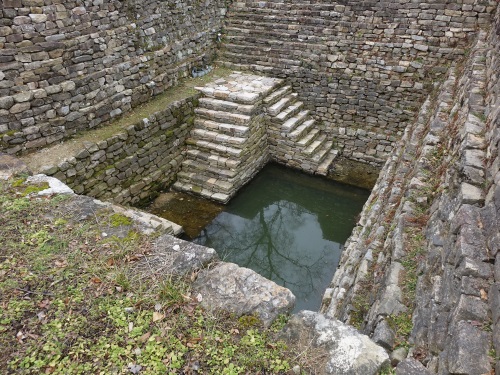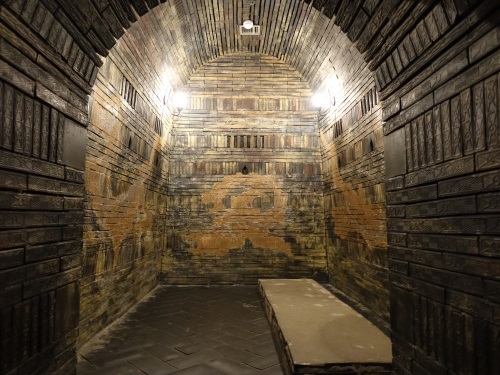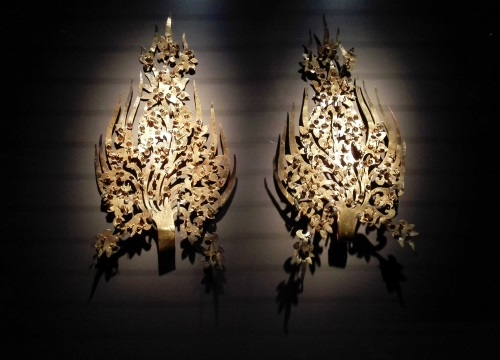Blog WHS Visits
WHS #623: Baekje sites in Gongju
The Baekje Historic Areas cover 8 archaeological sites in 3 clusters, representing the 3 former capital cities of this historic kingdom. During my stay in Seoul, I visited the Gongju cluster on a day trip by public transport. It was my first experience with Korea's long-distance bus system since my earlier visit in 2001, and it was a real pleasure to be transported on-time for only 7.20 EUR on a luxury coach with wide and comfy seats. It took 1.5 hours from the Seoul Express Bus Station to Gongju Bus Station.
 Gongju nowadays has an odd city plan, with the river splitting it in two. A quick look at this provincial city proves that not everywhere in South Korea is as modern and prosperous as Seoul. The two components of the WHS are clearly visible from afar, each covering a hilltop near the river bridge closest to the city center. I first walked to Gongsanseong fortress. As I had spent the day before at Namhansanseong, I couldn’t bring up much enthusiasm for yet another Korean fortress. The flags are yellow here (“the national colour of Baekje, representing the center of the universe”), the walls steep and the main area without much sites of interest. Very little reminds of the Baekje area: the absolute low point is the “Site of Baekje Building”, which is just a flat piece of grass land.
After half an hour or so I decided to move on to the second component of the WHS and the renowned Gongju museum. As said, this part is also clearly visible on a hill – but how to get there? I went on foot from the fortress, and quite nearby there’s a sign pointing to ‘Jeongjisan Archaeological Site’. However I ended up in a residential area with fiercely barking dogs, and never found any access to the WH area from this approach.
Gongju nowadays has an odd city plan, with the river splitting it in two. A quick look at this provincial city proves that not everywhere in South Korea is as modern and prosperous as Seoul. The two components of the WHS are clearly visible from afar, each covering a hilltop near the river bridge closest to the city center. I first walked to Gongsanseong fortress. As I had spent the day before at Namhansanseong, I couldn’t bring up much enthusiasm for yet another Korean fortress. The flags are yellow here (“the national colour of Baekje, representing the center of the universe”), the walls steep and the main area without much sites of interest. Very little reminds of the Baekje area: the absolute low point is the “Site of Baekje Building”, which is just a flat piece of grass land.
After half an hour or so I decided to move on to the second component of the WHS and the renowned Gongju museum. As said, this part is also clearly visible on a hill – but how to get there? I went on foot from the fortress, and quite nearby there’s a sign pointing to ‘Jeongjisan Archaeological Site’. However I ended up in a residential area with fiercely barking dogs, and never found any access to the WH area from this approach.
 I had brought a sketch of a map with me, and it seemed to show the main entrance of the complex to the back of the hill. So that meant another rather long walk on the Gongju pavements. Finally I ended up at the Royal Tombs of Songsan-ri. The area seemed deserted, but when I approached a ticket seller lifted the shutter of his booth and sold me a ticket. Then a trail awaits along the underground exhibitions and the tumuli outside. The interiors of the tumuli are all closed off nowadays, so the underground exhibition is the only way to admire the creative, Chinese inspired way of burial chamber design of the Baekje. Undoubted highlight is the tomb of King Muryeong: it looks as if he was buried in a book case!
The outdoor area is nice enough for a short stroll, but doesn’t bring more than a series a grassy bumps that cover the original graves. The trail along the tumuli ends at the far end of the archaeological area, and that’s where the entrance to the Gongju Museum lies. It’s a gigantic modern building. At the entrance I’m overloaded with free brochures, including a map of the whole Baekje area (including the other former capitals next to Gongju). The main hall on the first floor is dedicated to the findings from the Songsan-ri tombs. The most impressive one is that of the aforementioned King Muryeong. He and his wife were buried with many of their possessions such as weapons, tableware (from China), jewelry and shoes. A couple of the exhibits are currently away on loan to the National Museum in Gongju, where I had also admired them about a week ago.
I had brought a sketch of a map with me, and it seemed to show the main entrance of the complex to the back of the hill. So that meant another rather long walk on the Gongju pavements. Finally I ended up at the Royal Tombs of Songsan-ri. The area seemed deserted, but when I approached a ticket seller lifted the shutter of his booth and sold me a ticket. Then a trail awaits along the underground exhibitions and the tumuli outside. The interiors of the tumuli are all closed off nowadays, so the underground exhibition is the only way to admire the creative, Chinese inspired way of burial chamber design of the Baekje. Undoubted highlight is the tomb of King Muryeong: it looks as if he was buried in a book case!
The outdoor area is nice enough for a short stroll, but doesn’t bring more than a series a grassy bumps that cover the original graves. The trail along the tumuli ends at the far end of the archaeological area, and that’s where the entrance to the Gongju Museum lies. It’s a gigantic modern building. At the entrance I’m overloaded with free brochures, including a map of the whole Baekje area (including the other former capitals next to Gongju). The main hall on the first floor is dedicated to the findings from the Songsan-ri tombs. The most impressive one is that of the aforementioned King Muryeong. He and his wife were buried with many of their possessions such as weapons, tableware (from China), jewelry and shoes. A couple of the exhibits are currently away on loan to the National Museum in Gongju, where I had also admired them about a week ago.
 So that’s all there is. I must say that the museum exhibits and the underground reconstruction of the tombs were the most impressive. There’s not much left of the structures that the Baekje built. For future visitors to Gongju and both WH locations, I’d like to suggest taking a taxi or local bus (101 apparently) from the bus station to the Gongju National Museum. I walked everywhere, and especially the way back from the museum to the bus station across the river is tiring.
So that’s all there is. I must say that the museum exhibits and the underground reconstruction of the tombs were the most impressive. There’s not much left of the structures that the Baekje built. For future visitors to Gongju and both WH locations, I’d like to suggest taking a taxi or local bus (101 apparently) from the bus station to the Gongju National Museum. I walked everywhere, and especially the way back from the museum to the bus station across the river is tiring.
Lotus Pond at Gongsanseong Fortress
Reconstructed tomb of King Muryeong
Baekje crown ornaments in National Museum
Els - 14 January 2017
Comments
Kyle (winterkjm) 14 January 2017
"it looks as if he was buried in a book case!" I love this description, great pictures by the way.